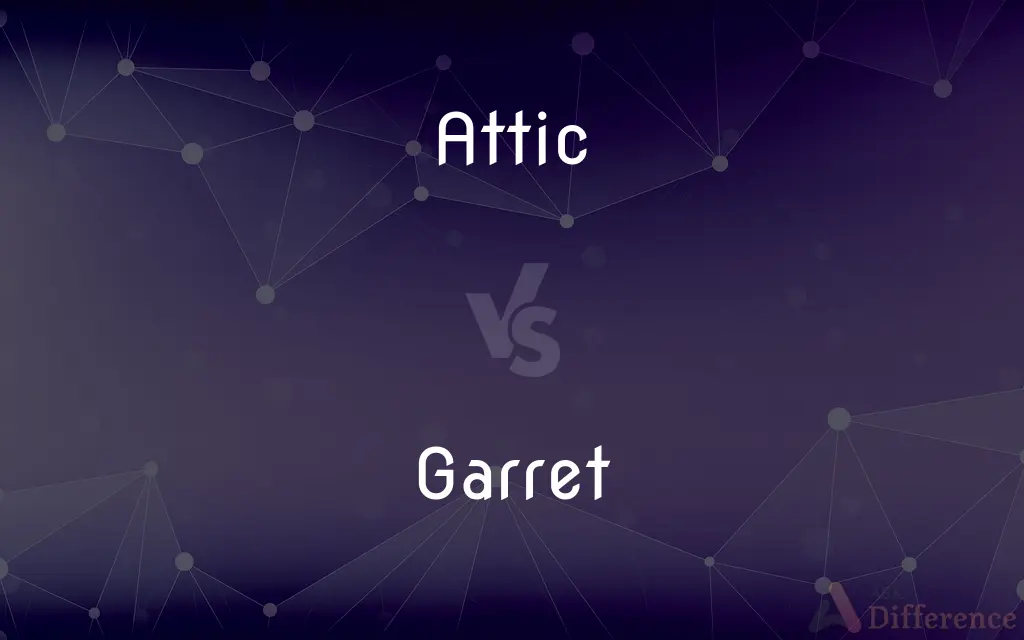Attic vs. Garret — What's the Difference?
Edited by Tayyaba Rehman — By Maham Liaqat — Updated on February 23, 2024
An attic is a space directly below the pitched roof of a house, often used for storage, while a garret is a small, often cramped attic room, typically under a sloping roof.

Difference Between Attic and Garret
Table of Contents
ADVERTISEMENT
Key Differences
An attic is a space found directly below the pitched roof of a house or building, serving various purposes from storage to additional living space. Attics span the entire footprint of the building below, offering ample space that can be finished or unfinished. A garret refers specifically to a small, often cramped room within the attic, typically characterized by its sloping ceilings that conform to the roof's pitch.
Attics are accessible via stairs or a ladder and can be adapted for different uses, including bedrooms, offices, or recreational areas, depending on their height and the presence of windows for natural light and ventilation. Garrets are historically associated with artists or writers seeking affordable living spaces, offering just enough room for basic living needs. The term carries a romantic or bohemian connotation, evoking images of creative but modest living quarters. Garrets are less about the space they offer and more about their specific use and cultural associations.
Both attics and garrets are located under the roof of a building, their perceived livability and use differ. Attics can be converted into spacious, well-lit rooms if they are properly finished and meet building codes for living spaces. Garrets, given their size and often limited accessibility, are more suited to singular uses like studios or small living areas and may face restrictions in terms of renovation and comfort.
The accessibility and functionality of attics and garrets also differ. Attics can often be easily integrated into the home's central heating, cooling, and electrical systems, making them more livable. Garrets, due to their size and location, might require more specialized solutions to ensure comfort and livability, such as skylight windows for natural light and ventilation systems to counteract their typically poor air circulation.
Attics have a broad association, from storage spaces filled with memories and heirlooms to luxurious additional living areas. Garrets, however, have a specific cultural image tied to the struggles and aspirations of artists and writers, symbolizing both isolation and the pursuit of creative endeavors within urban landscapes.
ADVERTISEMENT
Comparison Chart
Definition
A space under the roof of a house, used for storage or as additional living space.
A small, cramped room within an attic, often with sloping ceilings.
Size and Space
Can span the entire footprint of the building below.
Smaller, confined to a specific area within the attic.
Usage
Versatile; used for storage, bedrooms, offices, etc.
Traditionally used as affordable living or working spaces, especially for artists.
Accessibility
Generally accessible via stairs or a ladder; can be integrated into the home's systems.
May have limited access and require specific solutions for light and ventilation.
Cultural Connotations
Broad, ranging from storage to luxurious living spaces.
Associated with artistic or bohemian lifestyles.
Compare with Definitions
Attic
Can house mechanical equipment like HVAC systems.
The HVAC system's ductwork runs through the attic.
Garret
Symbolizes economic necessity and creative endeavor.
The novelist's first book was written in a cramped city garret.
Attic
Often requires insulation and ventilation improvements for living use.
The attic renovation included adding new windows for better light.
Garret
A quaint, small attic room, historically a modest living space.
The artist spent her days painting in the sunlight of her garret.
Attic
Offers potential for creative home expansion.
Their attic became a vibrant playroom for the kids.
Garret
Requires innovative solutions for comfort due to size.
They installed a skylight in the garret for natural light.
Attic
The space, often unfinished and with sloped walls, directly below the roof in the uppermost part of a house or other building, generally used for storage or habitation.
We went up to the attic to look for the boxes containing our childhood keepsakes.
Garret
A room or set of rooms immediately under the roof of a building; an attic.
Attic
A spacious area under the roof for storage or additional rooms.
They converted their attic into a cozy guest bedroom.
Garret
Characterized by sloped ceilings that limit headroom.
The garret's sloped ceilings added charm but required careful furniture placement.
Attic
An attic (sometimes referred to as a loft) is a space found directly below the pitched roof of a house or other building; an attic may also be called a sky parlor or a garret. Because attics fill the space between the ceiling of the top floor of a building and the slanted roof, they are known for being awkwardly shaped spaces with exposed rafters and difficult-to-reach corners.
Garret
A garret is a habitable attic, a living space at the top of a house or larger residential building, often small, dismal, and cramped, with sloping ceilings. In the days before elevators this was the least prestigious position in a building, at the very top of the stairs.
Attic
Floor consisting of open space at the top of a house just below roof; often used for storage
Garret
Often less accessible, making them private retreats.
His garret studio was his secluded sanctuary for writing.
Attic
Accessible by stairs, adding value to a home.
The pull-down stairs made attic access easy and convenient.
Garret
A top-floor or attic room, especially a small dismal one
The solitary genius starving in a cold garret
Attic
A story or room directly below the roof of a building, especially a house.
Garret
An attic or semi-finished room just beneath the roof of a house.
Common Curiosities
Do all houses with attics have garrets?
Not all houses with attics have garrets. A garret is a specific type of attic room, often smaller and with a sloping ceiling, which might not be present in all attics.
Are garrets only found in older buildings?
Garrets are more commonly associated with older, historical buildings, but small attic rooms in newer constructions might still be referred to as garrets based on their characteristics.
How do building codes affect attic and garret conversions?
Building codes can significantly impact the ability to convert attics or garrets into living spaces, with requirements for egress, ceiling height, insulation, and ventilation needing to be met. Garrets, due to their size and structure, might face more challenges in meeting these requirements.
How does the presence of an attic or garret affect home energy efficiency?
The presence of an attic or garret can significantly impact a home's energy efficiency. Proper insulation and ventilation in these spaces are crucial to prevent heat loss in winter and reduce heat gain in summer, impacting overall energy costs.
What are the common challenges in insulating attics and garrets?
Common challenges include dealing with limited space for insulation in garrets, ensuring proper ventilation to prevent moisture buildup, and addressing uneven temperatures due to the roof's proximity.
Can an attic be converted into a garret?
Technically, an attic conversion usually aims to create a more spacious and livable area, whereas a garret is inherently a smaller, specific part of an attic. The term "convert" might not apply to creating a garret from an attic.
Is it more expensive to renovate an attic or a garret?
Renovation costs depend on the extent of the work needed. Attic renovations can be more extensive and costly due to the larger area, but garret renovations might require specialized solutions for light, ventilation, and maximizing space, which can also increase costs.
Can both attics and garrets serve as emergency living spaces?
While both can potentially serve as emergency living spaces, modifications must meet safety and comfort standards, such as adequate access, insulation, and ventilation. Garrets, due to their smaller size and potential access issues, might be less suited for this purpose without significant alterations.
What are some creative uses for attics and garrets besides storage or living spaces?
Attics and garrets can be creatively used as home offices, art studios, meditation or yoga spaces, libraries, or entertainment rooms. Their unique features, like sloped ceilings in garrets, can add character to these specialized spaces.
How do local building codes and regulations impact the renovation of attics and garrets?
Local building codes and regulations can significantly impact renovations, with specific requirements for structural integrity, egress windows, staircases, ceiling height, and fire safety. Compliance is crucial for legal and safety reasons, and permits may be required before beginning any renovation work.
Share Your Discovery

Previous Comparison
Effervescence vs. Efflorescence
Next Comparison
Tornado vs. TwisterAuthor Spotlight
Written by
Maham LiaqatEdited by
Tayyaba RehmanTayyaba Rehman is a distinguished writer, currently serving as a primary contributor to askdifference.com. As a researcher in semantics and etymology, Tayyaba's passion for the complexity of languages and their distinctions has found a perfect home on the platform. Tayyaba delves into the intricacies of language, distinguishing between commonly confused words and phrases, thereby providing clarity for readers worldwide.














































